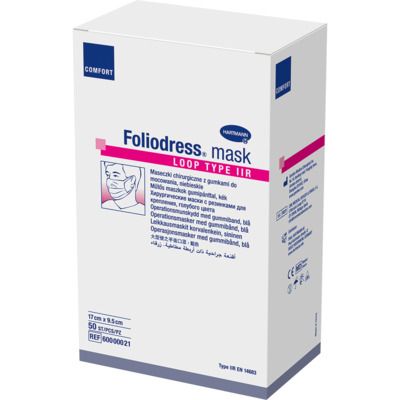Reports & expert advice
Urge incontinence - when the bladder is under constant pressure
You're out and about, feel fine, then suddenly it strikes: a bladder pressure so strong that you almost - or actually - can't hold it in. Unlike stress incontinence, the problem here is not that the pelvic floor is too weak, but that the bladder muscle, the so-called detrusor, is too strong. Read on to learn about urge incontinence and what you can do about it.

Urge incontinence can be very troublesome. Fortunately, there are many things you can do about it.
What is urge incontinence?
Urge incontinence (also called urinary incontinence) is a bladder storage disorder. It is an involuntary leakage of urine caused by an urge in the bladder that is simply too great to contain. This usually happens even though the bladder is not yet completely full. The bladder muscle suddenly contracts so strongly that even the strongest sphincter muscle can no longer withstand this pressure, gives way and urine leaks out. The good news is that often there are things you can do to alleviate the symptoms.
The topics in this article:
Blog.Share
Causes of urge incontinence
There are many reasons why this type of incontinence can occur. And they are not always directly related to the bladder:
Sensory urge incontinence:
This is where incontinence occurs because the receptors in the bladder are not working properly. In order for your bladder to function properly - to know when it is full and to transmit that information to the brain - there are small sensors located on the bladder wall. They measure exactly how full your bladder is and communicate this value to your brain via nerve fibres in the spinal column. If these sensors are incorrectly polarised or no longer function properly, they send incorrect information that the bladder is full when in reality it isn’t. Reasons for a malfunction of these sensors can be bladder infections, bladder stones, tumours in the bladder, or a narrowed urethra or a lack of oestrogen in women.1
Motor urge incontinence:
In motor urge incontinence, the problem is not in the bladder itself, but in the nerve fibres that transmit the impulses sent by the sensors to the brain. If these nerves do not function properly and send the signals to the brain too early or incorrectly, it can appear that the bladder is full and there is a sudden urge to urinate. Causes for damaged nerve cords include problems in the intervertebral disc, pinched nerves or diseases such as Parkinson's or multiple sclerosis.
Psychological causes of urge incontinence:
Urge incontinence can be psychosomatic. This means that no physical cause is found. It is common to have to go to the toilet more often when we are excited or anxious, for example, before a lecture or a job interview. It is said that the bladder is a mirror of the soul. Alternative practitioners see it as reflecting the passage of emotions through our bodies. If we don't give our emotions free rein, this can be reflected physically as a bladder problem. Urge incontinence, which puts pressure on the body, can be a sign that we are putting too much pressure on ourselves and setting ourselves goals that we cannot achieve or can only achieve with difficulty. If no physical causes for the incontinence are found, it makes perfect sense to take a closer look at your mental health.
Urge incontinence in men
Urge incontinence in men is often due to the prostate. A benign or malignant disease or enlargement can cause the development of an overactive bladder with urge symptoms. If the prostate is enlarged, this can lead to several problems. It can narrow the urethra, which in turn has a negative effect on bladder function. This disorder can lead to the bladder no longer emptying completely, resulting in so-called overflow incontinence. In addition, the residual urine can cause infections or bladder stones, which in turn can promote urge incontinence.

Urge incontinence in women
With increasing age, urge incontinence occurs more frequently in women. Urge incontinence is often due to hormonal changes during pregnancy or the menopause. When oestrogen levels drop, your bladder may respond more strongly to certain substances in the urine, sending you to the toilet more frequently and urgently. This in turn makes the bladder more susceptible to inflammation. A lack of oestrogen can also weaken the pelvic floor and connective tissue, leading to a sagging bladder or uterus. This can also lead to an overactive bladder.
What can be done about urge incontinence?
The good news is that there are a few things you can do about the sudden and urgent need to urinate:
Medicine
If no explanation for urge incontinence is found, i.e. no urinary stones or inflammation, there are various medications for treatment that can provide relief. So-called anticholinergics are often used in the treatment of urge incontinence. These act on the receptors in the bladder and prevent the bladder muscle from contracting too quickly and too strongly. If the urge incontinence in women is due to a lack of oestrogen, oestrogen-containing suppositories or creams can be effective. These are inserted locally into the vagina and are supposed to improve blood circulation and thus increase the capacity of the bladder.2
I highly encourage you to seek for professional medical advice.
Botox
The nerve toxin Botox is no longer only used to eliminate wrinkles. It is now used to treat migraines and hyperhidrosis, i.e. excessive sweating. It blocks the interface between nerves and muscles so that the muscles can no longer tense and cramp. And that is exactly why it is now increasingly used for urge incontinence. Botox is injected directly into the bladder wall. The full effect occurs after about ten days and lasts between three and nine months.
Natural treatment of urge incontinence
Natural treatment of urge incontinence
In addition to prescription tablets, there are a number of things that you can do yourself to support your bladder.
Toilet training
Toilet training involves learning to lengthen the time between emptying the bladder. The idea is to re-educate the bladder by delaying going to the toilet when you get the urge. The best way is to gradually lengthen the time between toilet visits. Start by delaying the urge to go to the toilet for five minutes. After a period of getting used to it, slowly increase the time to ten minutes, and so on. In this way, you can gradually regain control over your bladder.
Quality products make everyday life easier
Using solutions specifically designed for incontinence can help you manage bladder weakness and feel secure during the day and night. With the right pads or incontinence pants, you can manage your incontinence securely and discreetly, with no unpleasant odours or leaks.
For example, the MoliCare lady pads. These are available from 0.5 drops for very light to 5 drops for moderate urinary incontinence. These offer a high level of discretion thanks to a breathable, textile-like backsheet no unpleasant rustling or sweating. The absorbent core quickly absorbs fluid, transports it safely inside and leaves the skin feeling dry all over, odours are also neutralised. The antibacterial material and its fast absorption of liquid preserve the skin's protective acid mantle and is particularly gentle on the skin, as the pH balance is maintained.

Get 20% off on MoliCare® Premium
Simply enter the code PINKELBELLE20 when placing your order and receive a 20% discount.
About the author - Birgit Bulla
As the “owner of an incredibly annoying bladder” herself, Birgit knows from personal experience what it means to live with bladder weakness: In her mid-twenties, out of nowhere, she suddenly got an irritable bladder. After many years of struggling with this condition she finally started her own blog “Pinkelbelle” in 2018 to offer emotional support, inform about new research and – most importantly – show her readers that they are not alone with this problem.
Almost two years ago Birgit also published her first book “Everything you need to know about your bladder”, which has been translated into more than four languages. She now lives in Munich, where she works as an online editor and author. Over the years Birgit has become a real expert in the field of bladder health. It seems almost too fitting that her surname “Bulla” also translates from Latin as bladder.

1https://www.pflege.de/krankheiten/inkontinenz/harninkontinenz/dranginkontinenz/
2Dranginkontinenz - eine Form der Inkontinenz | Stiftung Gesundheitswissen (stiftung-gesundheitswissen.de)
Always safe, always confident - with Molicare®
MoliCare® from HARTMANN provides reliable leakage protection and maintains healthy skin with pH-neutral value for effective incontinence management. For light, moderate or severe incontinence.
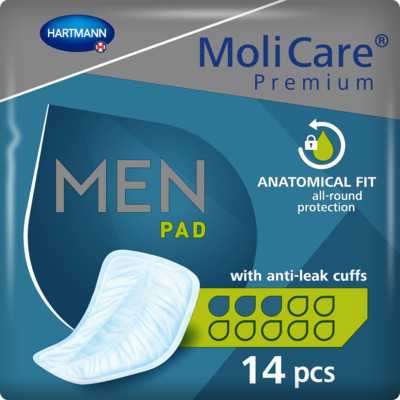
MoliCare® Premium Men Pad 3 Drops
<h2>Suitable for men with bladder weakness</h2> <p>Suitable for men of all age groups, body shapes and sizes, it truly is a one size fits all with this range. It is never pleasant to go about daily activities with the potential risk of an incontinence slip, MoliCare® have created the Premium Men Pad 3 drops, designed with a V-Shape to comfortably fit around the desired area, and has a textile-like back sheet for extra protection.</p> <p>To make sure that you choose a premium men pad that is right for you, check out the additional features of this product range:</p> <h2>Leakage protection for men you can rely on</h2> <p>With a body-shaped design, these absorbent mens pads offer reliable protection for men with light bladder weakness. The soft, cotton-like materials ensure discreet comfort, and the odour neutraliser keeps you feeling fresh and confident.</p> <h2>Secure fit and skin-friendly</h2> <p>The Premium MEN Pads feature a wide adhesive strip for secure fixation in your regular underwear, providing you with peace of mind during your daily activities. The soft and breathable materials are gentle on your skin, maintaining its health with a skin-friendly pH.</p> <h2>All-round protection for men</h2> <p>MoliCare® Premium MEN Pads are equipped with a quick dry system, anti-leakage system, and cuffs for added security, ensuring all-round protection you can trust. Dermatologically tested, these pads are safe and reliable for daily use.</p> <h2>Tailored for your needs</h2> <p>Available in different absorbency levels, MoliCare® incontinence products for men cater to varying degrees of incontinence, providing you with the level of care that suits your needs. MoliCare® Premium MEN Pads are perfect for daily wear or when you need extra protection against slight to moderate incontinence. Discreet and comfortable, they enable you to maintain your active lifestyle with confidence.</p> <h2>Fast and reliable delivery</h2> <p>Our quick ordering service makes it easy to get the incontinence products you need. Additionally, our price match promise ensures you get both quality and value for money.</p> <p>Enjoy fast delivery on all orders over £50 when you purchase from HARTMANN Direct.</p>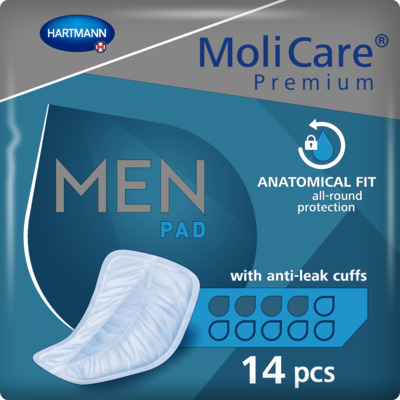
MoliCare® Premium Men Pad 4 Drops
<h2>Comfortable and absorbent</h2> <p>Why MoliCare for men? Hers are some of the key features of the MoliCare® Premium Men Pads from Hartmann:</p> <ul> <li>Discreet and comfortable</li> <li>Fits the male physique</li> <li>3-layer absorbent core</li> <li>Fast-absorbing system</li> <li>Anti-leakage cuffs</li> <li>Odour neutralisers</li> <li>Wide adhesive strip</li> <li>Skin-friendly</li> </ul> <p>With an affordable price and great quality guarantee, you cannot regret choosing MoliCare® Premium Men Pad 4 drops, equipped with anti-leak cuffs, and 14 pieces per bag.</p> <h2>Slim and discreet under clothing</h2> <p>MoliCare® Premium MEN Pads offer reliable support for men dealing with bladder weakness. Whether it's stress incontinence or urge incontinence, these pads for men are designed to provide a discreet and quick solution on the go. Simply place the pad before applying your underwear and secure it with the adhesive strip for worry-free protection. MoliCare® Premium MEN Pads offer full coverage for men facing very light to moderate bladder weakness.</p> <h2>Leakage protection for men</h2> <p>MoliCare® understands that each individual's incontinence needs are unique. That's why our incontinence products, including MoliCare® Premium MEN Pads, are available in different absorbency levels. You can find the perfect fit and protection for your specific requirements.</p> <h2>Reliable and soft on the skin</h2> <p>Our body-shaped absorbent pads are designed to deliver dependable and skin-friendly incontinence protection every day. Experience discreet comfort with the soft, cotton-like materials and the added benefit of an odour neutraliser, ensuring you feel fresh and confident throughout the day.</p> <h2>Fast delivery to your home</h2> <p>At HARTMANN Direct, we ensure a fast delivery service for all our products. Enjoy free delivery on orders over £50, making it convenient and hassle-free to receive the incontinence products you need. Our dedicated customer care team is here to discuss your incontinence product needs and answer any questions you may have. Call us today on 0800 028 9470 to experience the comfort and confidence that MoliCare® Premium MEN Pads can provide.</p>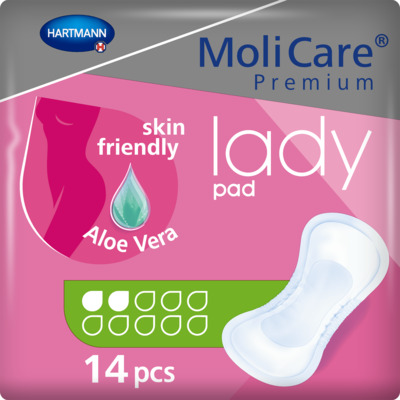
MoliCare® Premium Lady Pad 2 Drops
<h2>Skin Friendly Pant Liners</h2> <p>For women that experience slight incontinence and bladder weakness, across different age groups, it can be a challenge to find the right bladder weakness product that is easy to apply and wear without the worry of potential leakages. Fortunately, we understand this approach, hence why we are happy to offer our MoliCare® Premium Lady Pad 2 drops, that is skin-friendly, Aloe Vera applied, and comes with 14 liners per bag.</p> <h2>Slim and discreet liners</h2> <p>Whether dealing with stress incontinence or urge incontinence, these panty liners offer a discreet and easy solution on the go. Simply place the pad in your underwear and secure it with the adhesive strip for all-round protection. Available in different absorbency levels, MoliCare® bladder weakness products cater to all levels of bladder weakness, ensuring secure care.</p> <h2>Control Bladder Weakness</h2> <p>Enjoy the benefits of these body-shaped absorbent panty liners, designed for women with bladder weakness. The pads offer discreet, reliable protection with features including odour control and fast absorption.</p> <p>With a wide adhesive strip, you can comfortably fix the pad in your regular underwear, providing secure and comfortable fixation. The pads are skin-friendly, featuring soft, breathable materials, including foam cuffs, and a top sheet treated with Aloe Vera.</p> <p>Keeping your skin healthy is a priority, which is why MoliCare® Premium Lady Pads have a skin-neutral pH value of 5.5 and an antibacterial finish. They are also dermatologically tested, offering peace of mind.</p> <h2>Buy pant liners online</h2> <p>Never worry about running out with our convenient order service and fast delivery direct to your door. Enjoy free shipping on orders over £50.</p> <p>If you need assistance, our professional customer service team is here to support you in choosing the right product. Reach out to us today at 0800 028 9470 and experience the comfort and reliability of MoliCare® Premium Lady Pads.</p>
MoliCare® Premium Men Pad 3 Drops (ISO 441ml)
<p><strong>Reliable and discreet incontinence pads for men with an instant-dry feeling</strong></p> <p>Bladder weakness is difficult to live with, the last thing you want to worry about is incontinence protection. That’s why our best-ever MoliCare® premium MEN Pad 3 drops offer an <strong>all-round protection</strong> that keeps everything dry and comfortably in place while fitting discreetly in your regular underwear.</p> <p>The incontinence pad for men quickly <strong>removes urine from the surface up to 86 %* faster than before</strong> and neutralises unpleasant odours to leave you feeling instantly dry and in control thanks to the new <strong>MoliCare SkinGuard</strong>®<strong> Absorbent Core Technology</strong>. This skin-friendly technology not only helps you feel up to 90 %* drier than previous MoliCare® premium<strong> </strong>MEN pads, it also helps to maintain healthy skin and preventing irritation.</p> <p><strong>Engineered for the male anatomy</strong> and dermatologically tested for maximum skin compatibility, these male urinary pads do not contain colour, perfume or latex making them environmentally friendly too.</p> <p>*Compared to last generation</p>
Baktolin Pure hand wash
<p>The sensitivity-friendly formula of Baktolin Pure Hand Wash makes it popular amongst doctors, nurses and carers, who need to wash and disinfect their hands multiple times throughout the day. This generous 500ml Pure hand wash bottle comes with a hand pump dispenser for easy dosing.</p> <p>• pH-neutral, mild formula<br /> • Ideal for sensitive skin<br /> • Made with skin-mild tensides which preserve the acid mantle of the skin<br /> • Paraben, fragrance and colourant-free</p> <p>When you order disinfection products from HARTMANN Direct, you can be assured that you will only receive the highest quality of product and customer support. Our disinfection range is ideal for users at home, all healthcare professionals and their patients. They are used in a wide range of settings, from residential homes and assisted living facilities to patients own homes.</p> <p>If you would rather place your order over the phone or you aren’t certain what you are looking for, please call our helpful customer service team on 0800 028 9470. </p>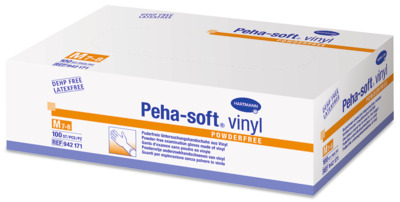
Peha Soft® Vinyl Disposable Gloves (powder free)

Peha Soft Latex Disposable Gloves

Baktolin Pure hand wash
<p>The sensitivity-friendly formula of Baktolin Pure Hand Wash makes it popular amongst doctors, nurses and carers, who need to wash and disinfect their hands multiple times throughout the day. This generous 500ml Pure hand wash bottle comes with a hand pump dispenser for easy dosing.</p> <p>• pH-neutral, mild formula<br /> • Ideal for sensitive skin<br /> • Made with skin-mild tensides which preserve the acid mantle of the skin<br /> • Paraben, fragrance and colourant-free</p> <p>When you order disinfection products from HARTMANN Direct, you can be assured that you will only receive the highest quality of product and customer support. Our disinfection range is ideal for users at home, all healthcare professionals and their patients. They are used in a wide range of settings, from residential homes and assisted living facilities to patients own homes.</p> <p>If you would rather place your order over the phone or you aren’t certain what you are looking for, please call our helpful customer service team on 0800 028 9470. </p>